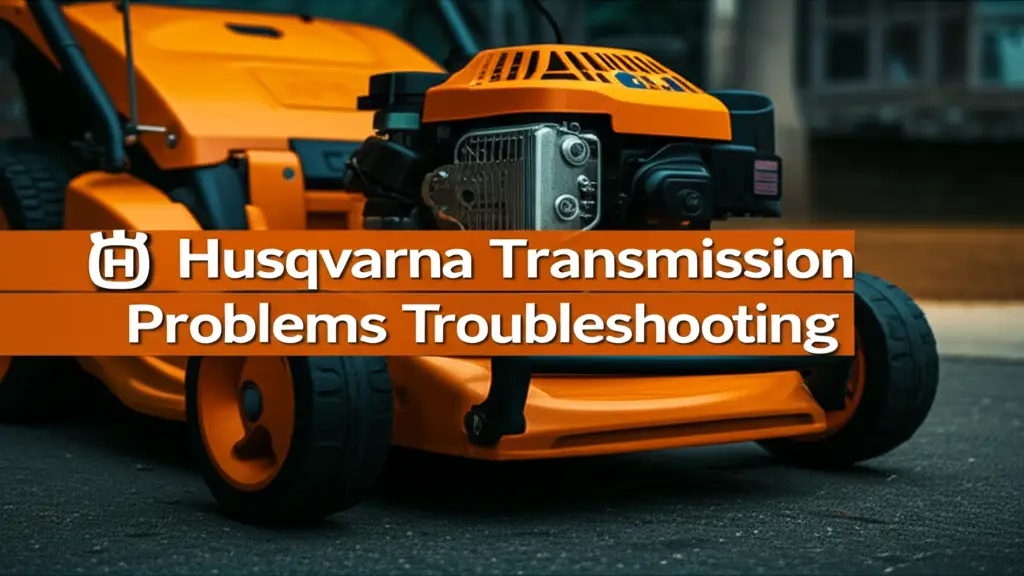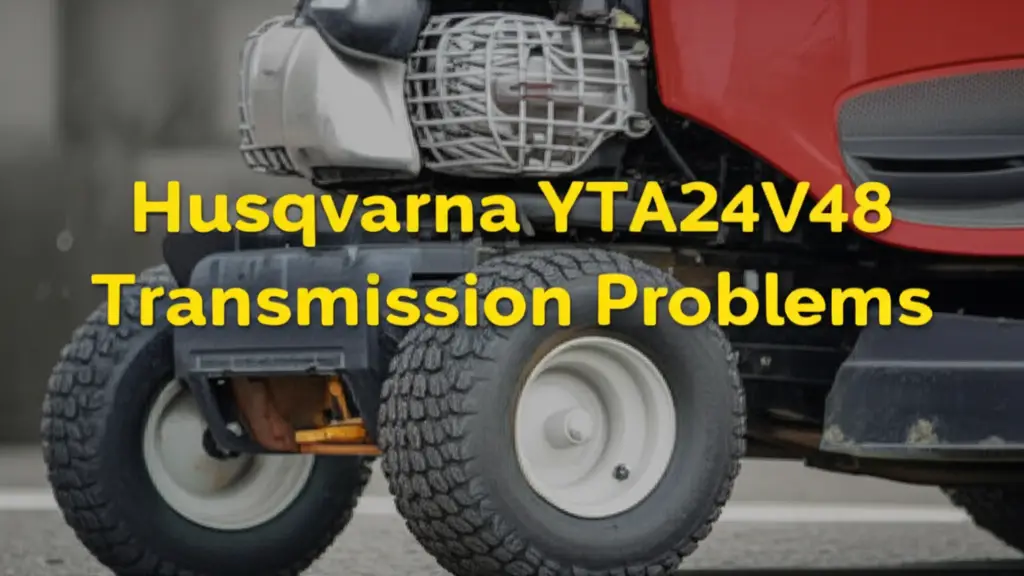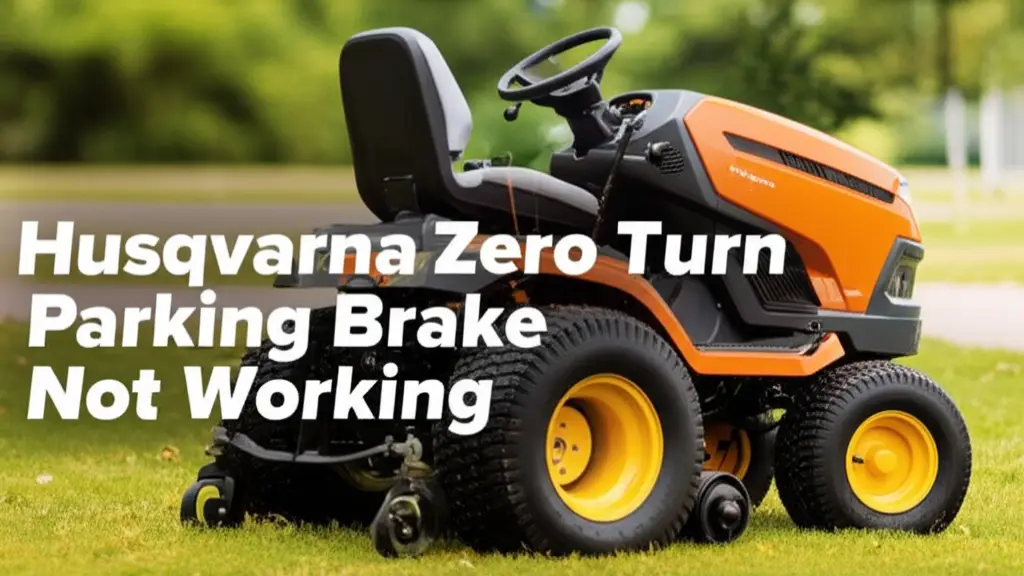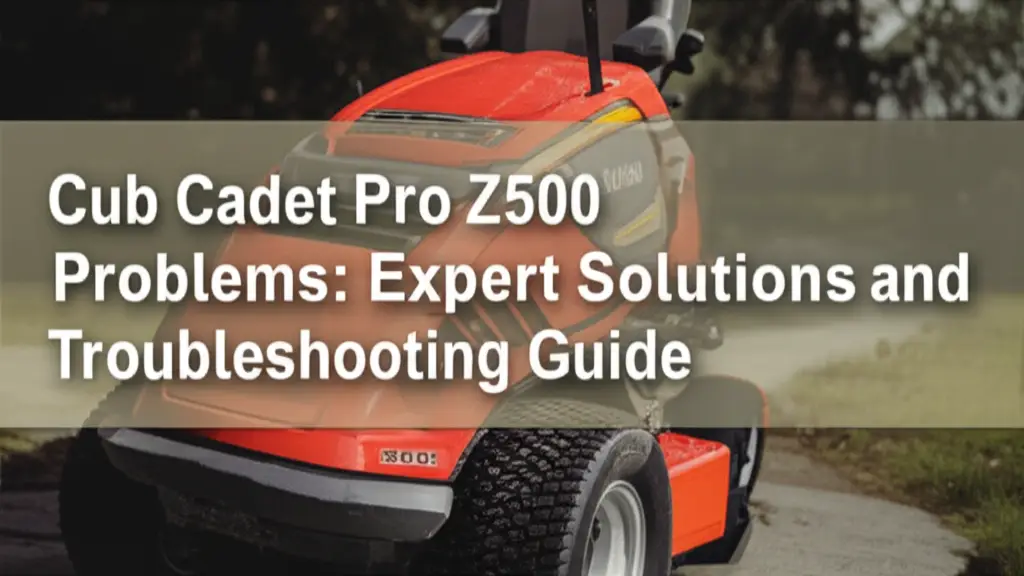· Troubleshooting · 21 min read
Husqvarna Zero Turn Mower Problems
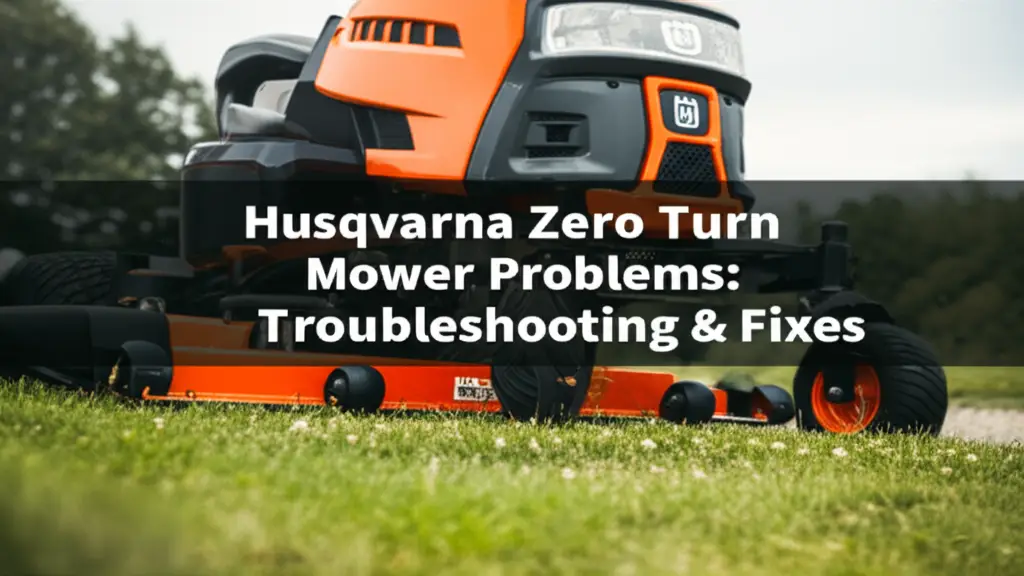
Husqvarna Zero Turn Mower Problems: Troubleshooting & Fixes
Few things are as frustrating as a Husqvarna zero-turn mower that won’t cooperate when it’s time to tackle the lawn. These powerful machines, including popular models like the Husqvarna Z254 and RZ5424, are designed for efficiency and precision, but like any complex equipment, they can encounter issues.
From starting woes to steering difficulties or uneven cuts, understanding common Husqvarna zero turn mower problems is key to keeping your machine running smoothly.
This comprehensive guide will walk through the most frequent issues, offering practical troubleshooting steps and effective solutions to get a mower back in top shape.
Takeaway:
- Regular maintenance is the best defense against common Husqvarna zero turn mower problems.
- Always check the simplest solutions first: fuel, battery, spark plugs, and safety switches.
- Proper tire pressure and deck leveling are crucial for optimal cutting and steering.
- Do not hesitate to consult the owner’s manual or a certified technician for complex issues.
Husqvarna zero turn mower problems often stem from maintenance neglect, including battery and fuel system issues, transmission air, steering component wear, or dull blades.
Troubleshooting involves systematic checks of electrical, fuel, and mechanical systems, often resolved by cleaning, adjusting, or replacing specific parts, ensuring consistent performance and a pristine lawn.
Understanding a Husqvarna Zero Turn Mower
Husqvarna zero-turn mowers are renowned for their power, durability, and maneuverability, making them ideal for both hilly and flat terrains, offering elevated comfort during operation.
These machines are engineered for efficiency and precision, allowing users to cut large areas quickly and navigate tight spaces with ease. The ability to turn on a dime significantly reduces mowing time and effort, making them a preferred choice for residential and commercial landscaping alike.
Despite their robust design and high performance, mechanical issues can arise, which can be particularly daunting when a user depends on them for commercial or residential landscaping.
The complexity of a zero-turn mower, with its intricate hydraulic systems, powerful engines, and precise cutting decks, means that when something goes wrong, it can feel overwhelming.
The initial investment in such a high-performance machine implies a desire for consistent, high-quality results.
Therefore, when a problem occurs, the frustration extends beyond just a breakdown; it encompasses the loss of expected performance and the disruption to a meticulously planned lawn care routine.
This guide aims to empower owners to maintain that performance, not just fix a breakdown, by providing clear, actionable steps.
Acknowledging the “daunting” aspect of these issues creates a helpful and empathetic approach, building trust with the reader by positioning this guide as a reassuring, expert resource.
This section lays the groundwork for understanding the various systems involved in common problems, setting the stage for effective troubleshooting.
Common Husqvarna Zero Turn Mower Problems and Solutions
Problem: Mower Won’t Start (Starting Problems)
Description: Your Husqvarna zero-turn mower fails to crank, clicks without starting, or struggles to turn over.
Causes:
Battery & Electrical System Issues:
Corroded battery terminals, a low charge, bad connections, or a dying battery are frequent culprits.
The battery might be empty after winter storage or prolonged inactivity, as batteries naturally discharge over time, especially in cold conditions.
A blown main 20-amp fuse, often located under the dash, can sever the battery connection to the entire tractor.
If fuses repeatedly blow, it indicates a persistent short circuit within the electrical system.
A faulty charging system, such as a stator or alternator, can also prevent the battery from recharging.
Fuel System & Carburetor Troubles:
Clogged fuel filters, dirty or contaminated fuel, old fuel, or even an obstructed fuel cap vent can prevent the engine from receiving the necessary fuel.
Old gasoline degrades over time, forming gummy deposits that can clog fuel lines and carburetors.
Ethanol in modern gasoline can attract moisture and corrode fuel system components. A dirty carburetor can prevent proper fuel-air mixture.
Spark Plug & Air Filter Diagnostics:
Dirty, damaged, or worn spark plugs can prevent proper ignition, leading to a no-start condition or hard starting.
A dirty or damaged air filter restricts the airflow crucial for combustion, leading to hard starting, reduced engine power, or poor performance.
Safety Switches & Interlock System:
Husqvarna zero-turn mowers are equipped with safety interlock systems designed to prevent accidental operation.
These systems will prevent the mower from starting if certain conditions are not met, such as the parking brake not being engaged, the cutting deck being lowered, or the operator not being properly seated.
The PTO (Power Take Off) switch must also be in the “off” position.
Solutions:
Battery & Electrical System:
Check battery terminals for any signs of corrosion or dirt; clean them thoroughly with a baking soda solution to ensure optimal conductivity. Secure any loose connections to the battery posts or wiring harness.
If the battery charge is low, charge it properly. If it drains quickly after charging or fails to hold a charge (reading less than 12.7 volts with a multimeter), it likely needs to be replaced.
Ensure the main 20-amp fuse is not blown; if it repeatedly blows, diagnose the short circuit using a 12-volt test light.
If the battery constantly dies despite being new or fully charged, the charging system should be tested.
Fuel System & Carburetor:
Clean or replace the fuel filter. Ensure the mower is using fresh, quality, and uncontaminated fuel.
Low-ethanol or ethanol-free fuel is recommended. If old or incorrect fuel is suspected, drain the tank immediately using a manual siphon pump and refill with fresh gasoline, considering a fuel additive.
Check for clogged fuel lines and clear any blockages using carburetor cleaner and compressed air; replace fuel lines if damaged.
Try running the mower with and without the fuel cap to diagnose an obstructed fuel cap vent. If the carburetor is dirty, clean it thoroughly or have it professionally serviced.
Spark Plug & Air Filter:
Inspect spark plugs for carbon buildup or cracked porcelain; clean them if necessary, or replace them if damaged, ensuring the correct gap settings are maintained.
Examine the air filter for blockages or excessive dirt buildup; clean or replace it annually or as needed. Ensure proper installation of the air filter.
Safety Switches:
Always ensure the parking brake is engaged, the cutting deck is lifted to the transport position, the operator is properly seated, and the PTO switch is in the “off” position.
Inspect the wiring to these safety switches for any damage or loose connections.
Quick Troubleshooting Guide for Starting Issues:
| Symptom | Common Causes | Quick Check/Solution |
|---|---|---|
| Mower won’t crank/click | Dead/low battery, Corroded terminals, Blown fuse, Faulty safety switch | Charge/replace battery, Clean terminals, Check/replace fuse, Engage brake/lift deck/reseat |
| Mower cranks but won’t start | Old/bad fuel, Clogged fuel filter, Dirty carburetor, Worn spark plug, Dirty air filter | Drain & refill fuel, Replace filter, Clean carb, Clean/replace plug, Clean/replace air filter |
| Mower starts then stalls | Old/bad fuel, Clogged fuel filter, Dirty carburetor, Dirty air filter | Drain & refill fuel, Replace filter, Clean carb, Clean/replace air filter |
| Mower hard to start | Old/bad fuel, Clogged fuel filter, Dirty carburetor, Worn spark plug, Dirty air filter | Drain & refill fuel, Replace filter, Clean carb, Clean/replace plug, Clean/replace air filter |
Problem: Lack of Movement (Transmission Problems)
Description: Your Husqvarna zero-turn mower starts but fails to move backward or forward, or exhibits sluggish response.
Causes:
Hydrostatic Transmission Issues:
Low transmission fluid levels, leaks in the hydraulic system, or trapped air within the fluid (cavitation) can prevent the pump from generating the necessary pressure to transmit power effectively.
This can lead to a significant reduction in torque, causing the mower to be sluggish or the cutting blade to struggle to spin at full speed.
Drive Belt & Linkage Concerns:
A broken or worn drive belt is a primary culprit for a lack of movement, as it transfers power from the engine to the transmission.
Defective or rusty pulleys, a misplaced or loose axle key, a missing or broken idler arm spring, or an incorrectly positioned drive release lever can also hinder movement.
Solutions:
Hydrostatic Transmission:
Regularly check the transmission fluid levels and add fresh oil if they are low. If the oil appears contaminated or old, it should be replaced.
Inspect hydraulic hoses and connections for any signs of damage or leaks. Ensure the pump cooling fins are clean to prevent overheating.
If sluggishness or loss of drive persists, it is crucial to purge the hydraulic drive system to remove any trapped air.
For more details on transmission issues, you can refer to resources on Husqvarna riding mower transmission problems.
Detailed Transmission Purging Procedure:
This procedure is vital for new mowers, units stored for long periods (over two months), or those experiencing sluggishness or loss of drive.
- Preparation: Place the rear of the mower safely onto jack stands on a level surface. Ensure the engine is off and the parking brake is set.
2. Disengage Transmission: Locate the freewheel control (typically at the back of the frame) and place it in the freewheeling position. For mowers with separate pumps and wheel motors, activate the freewheel by turning the bypass valves (one on each pump) two full turns.
3. Fill Reservoir: Confirm that the oil reservoir is filled to the specifications listed in the owner’s manual before beginning the purge procedure.
4. First Cycle (Engine On, No Load): Sit in the operator’s seat and start the engine. Once the engine is running, move the throttle control to the slow position. With the motion control levers in the neutral (N) position, slowly disengage the clutch/brake pedal. Move the motion control levers to the full forward position and hold for five (5) seconds. Then, move the levers to the full reverse position and hold for five (5) seconds. Repeat this sequence three (3) times. During this procedure, there may be some movement of the drive wheels, but they are not under load; this indicates that air is being removed from the hydraulic drive system.
5. Return to Neutral & Shut Off: Move the motion control levers to the neutral (N) position. Shut off the engine and set the parking brake. Check the oil level in the reservoir and add oil as needed.
6. Engage Transmission: Engage the transmission by placing the freewheel control into the driving position, or by closing the bypass valves on the pumps.
7. Second Cycle (Engine On, Movement): Sit in the operator’s seat and start the engine. After the engine is running, move the throttle control to half or full speed. With the motion control levers in the neutral (N) position, slowly disengage the clutch/brake pedal. Slowly move the motion control levers forward. After the tractor moves approximately five (5) feet, slowly move the motion control levers to the reverse position. After the mower moves approximately five (5) feet, return the motion control levers to the neutral (N) position. Repeat this procedure with the motion control levers three (3) times.
8. Completion: The mower is now purged and ready for normal operation.
Drive Belt & Linkage:
Carefully examine the drive belt, removing any broken or worn sections and replacing them with a new one.
Inspect pulleys for defects or rust; rusty pulleys should be lubricated, and any with non-rotating bearings should be replaced.
Ensure the axle key is properly positioned. Verify the condition of the idler arm spring, replacing it if it is missing or broken.
Check the drive release lever, as an incorrectly positioned lever can inadvertently disengage the drive system.
If your zero-turn mower won’t go forward or backward, further troubleshooting can be found in dedicated guides.
Problem: Steering Issues (Husqvarna Zero Turn Mower Steering Problems)
Description: The mower pulls to one side, making it challenging to drive straight or control precisely.
Causes:
Mower Pulling to One Side:
Uneven tire pressure, worn-out parts in the steering mechanism, or faulty dampers are common causes.
Worn Components:
Loose or worn components such as washers, bushings, and the gearing assembly within the steering system can weaken steering performance.
Defective or bad dampers also make steering tricky, as they are crucial for smooth and controlled movement.
Solutions:
Tire Pressure:
Check and adjust the tire pressure across all tires. Ensure all tires are inflated to the appropriate and equal pressure recommended by Husqvarna (for instance, rear tires on a Husqvarna Z254F should be adjusted to 15 psi or 103 kPa).
Steering Components:
Inspect the steering levers and linkage for any damage or obstruction. The linkage may need adjustment, or bushings might require cleaning or replacement if they are binding or worn.
Examine the steering system for any loose or worn components like washers, bushings, and the gearing assembly; replace any loose or worn parts to restore proper functionality.
Inspect the dampers and replace them if they are defective or bad. Regular maintenance of the steering system, including frequent inspections and lubrication of moving parts, can prevent premature wear.
When replacing parts, using genuine Husqvarna replacement components is often recommended for optimal performance and longevity.
For more in-depth troubleshooting of steering issues, consult resources on Husqvarna zero turn steering problems.
Problem: Blades Not Engaging (Husqvarna Zero Turn Mower Blade Engagement Problems)
Description: The mower’s blades fail to engage when the PTO is activated, preventing cutting.
Causes:
Common Reasons:
Malfunctioning drive belts or damaged engine belts are primary causes for blades failing to engage.
The belt could be stretched, loose, slipped off its pulleys, or even snapped. The accumulation of too much grass or leaves packed under the mower deck can create excessive drag or physically push off the belt.
PTO Clutch and Switch Issues:
The PTO (Power Take Off) clutch is a critical component that engages the drive belt to rotate the blades. If the PTO clutch is not receiving power, if its solenoid is defective, or if the clutch itself is worn out, the mower blades will not engage.
Similarly, a defective PTO switch, which supplies power to the PTO clutch, can also prevent blade engagement. A bad PTO knob can also be the cause.
Solutions:
Belts and Debris:
Inspect both the drive belt and engine belts for any signs of wear, damage, or improper seating; replace them if necessary.
Thoroughly clear any excessive grass clippings, debris, or binding materials like string, wire, or weeds from under the mowing deck that might obstruct blade movement or dislodge the belt.
PTO System:
Test the PTO switch for continuity using a multimeter; replace it if it is found to be defective.
If the PTO clutch is determined to be defective, it is typically not repairable and must be replaced.
If a bad PTO knob is suspected, it is often an easy and inexpensive fix. If your Husqvarna zero-turn shuts off when arms are engaged, it could be related to safety switches or PTO issues.
Problem: Uneven Cutting & Poor Mowing Quality
Description: The grass is not cut evenly, showing “feathering” or “streaking,” or the mower creates “divots” or “scalping” by striking the ground.
Causes:
Dull Blades & Uneven Streaks:
Dull or damaged blades tear rather than cleanly cut grass, leading to ragged edges and a less uniform appearance.
Wet grass clinging to the mower deck can obstruct the blades. Slow engine or blade speed can also contribute to feathering.
Mower Deck Adjustment & Leveling:
An incorrectly installed blade, uneven tire pressure, or a mowing deck not adjusted to a uniform height can all contribute to uneven cutting.
Physical damage to the mower, including the spindle around which the blade rotates, can also be a factor.
Preventing Divots and Scalping:
This problem typically arises either because the deck is not adjusted correctly for the terrain or because the terrain itself has changed (e.g., holes from sprinkler damage, wildlife, tree roots, or uplifted ground from mole/vole tunnels).
Solutions:
Blades:
Regularly check the blades for damage and sharpness.
Sharpen or replace them as needed, ideally every 8-10 hours of use or daily, depending on usage conditions and terrain.
If sharpening, ensure they are perfectly balanced before reinstallation.
Mower Deck:
Clear any clogs or grass clipping buildup from under the mower deck. Avoid mowing overly wet grass.
Ensure the engine or blade speed is appropriate for the conditions. Ensure the blade is installed correctly and is spinning on a horizontal line.
Check the tire pressure across all tires; a single low tire can cause the deck to tilt. Adjust the mowing deck to a uniform height using Husqvarna’s detailed leveling procedure:
- Inflate all tires to their recommended pressures.
2. Place the mower on a flat, level surface, turn off the engine, remove the key, and allow it to cool.
3. Turn the blades to their widest position (side to side). Place the deck in the most used cutting position. Measure from the flat surface to the blade tip on both sides and compare readings. Adjust side-to-side linkages to within 1/8 inch.
4. Turn the blades so one is forward and one is rearward. Measure from the flat surface to the tip of the forward-most blade and the rear-most blade. The front should typically be 1/8 inch to 1/2 inch lower than the rear (preferably 1/4 inch to 3/8 inch, though this can vary by model/deck design). Make necessary adjustments for the correct pitch.
5. Repeat side-to-side adjustment after setting the front-to-back pitch, and repeat front-to-back if further adjustments are made.
6. Perform test cuts in the same direction side by side to verify the level.
Terrain & Spindle:
Inspect the spindle for any binding (from wire or string) or damage. Inspect the lawn area thoroughly for holes, fallen branches, or other terrain changes before mowing.
Always double-check and adjust mower deck settings to the proper height for the specific terrain.
Clean the mower deck after each use to prevent compacted grass from remaining. Ensure the blade itself is true and undamaged.
Problem: Engine Performance Issues (Power Loss, Excessive Fuel Consumption, Smoke Emission)
Description: The engine experiences a reduction in power or cutting torque, consumes more fuel than usual, or emits unusual smoke.
Causes:
Loss of Power or Cutting Torque:
Low transmission fluid level, a dirty air filter, a sputtering engine (possibly due to condensation in the gas), or binding around the cutting blade from debris (string, wire, weeds, or excessive grass inside the mowing deck). Incorrect engine RPM and governor settings can also contribute.
Excessive Fuel Consumption:
A blocked air filter, a poor quality spark plug, or drag under the cutting deck (e.g., from grass clippings or debris) can all increase fuel consumption. Dull mower blades force the engine to work harder.
Carburetor issues, such as an incorrect float level, high-speed governor setting, or pilot screw adjustment, can lead to an overly rich or lean fuel mixture.
Low cylinder compression pressure can also cause excessive fuel consumption.
Smoke Emission:
Smoke can indicate burning oil (due to overfilling the sump for 4-stroke engines, too much oil in fuel for 2-stroke engines, or a leaking cylinder gasket), engine compression problems, a defective engine breather assembly, or damaged components like dipsticks or valve covers.
For electric mowers, smoke typically means the motor is overheating, often from cutting long or dense grass, or a fault with the battery or motor itself.
Solutions:
Loss of Power:
Check the transmission fluid level and top it off if low. Clean or replace the air filter. Inspect the fuel filter for cleanliness and check for any condensation in the gas; drain and refresh the fuel if needed.
Thoroughly inspect the mowing deck for any binding issues. Ensure the engine’s RPM and governor settings are correct.
Excessive Fuel Consumption:
Check and replace the air filter and spark plug. Ensure nothing is caught under the cutting deck that might create drag.
Replace dull mower blades with sharp ones. For carburetor-related issues, inspect and adjust components like the float level, high-speed governor, and pilot screw.
For persistent compression issues, professional assistance is highly recommended.
Smoke Emission:
Check for oil leaks and maintain proper oil levels; ensure the sump is not overfilled (for 4-stroke engines) or that the fuel is not over-mixed (for 2-stroke engines).
Clean any excess oil from the engine and surrounding parts.
Inspect and repair engine components such as leaking cylinder gaskets, damaged valves, or spark plug cover seals.
For electric mowers, turn the unit off immediately and seek professional repair if smoke is observed.
For more serious concerns, especially those involving internal engine damage or persistent smoke after basic checks, consulting an authorized repair shop is strongly recommended.
General Maintenance Tips for Husqvarna Zero Turn Mowers
Many common Husqvarna zero turn mower problems are preventable with regular, diligent maintenance. Proactive care is key to extending the lifespan of the mower and ensuring consistent, reliable performance.
Essential Routine Checks for Longevity
Implementing a routine maintenance schedule can significantly reduce the likelihood of encountering major issues:
Blades:
Sharpen the mowing blade at least annually, or before tackling big mowing jobs. Before each use, check the blade for defects in the cutting edge or looseness.
Mowing Deck:
Clean the mowing deck thoroughly after each use to prevent grass clipping buildup and corrosion, which can affect cut quality and deck integrity. Annually, check and balance the deck adjustments to ensure an even cut.
Spindle:
Regularly check that wire or string does not become bound around the spindle, as this can impede blade rotation and cause damage.
Engine & Transmission:
- Oil: Check and change the engine oil as recommended in the owner’s manual, or more frequently after tough mowing jobs.
- Air Filter: Clean or replace the air filter at least annually, and often before use, as a dirty filter significantly reduces engine power.
- Transmission Fluid: Check transmission fluid levels and service the transmissions as recommended by the manufacturer.
Tires:
Check tire pressure and tread before each use; low pressure in a single tire can unbalance the mower deck and lead to uneven cutting or divots.
Fuel:
Always use quality, uncontaminated fuel and ensure the fuel filter is clean or replaced as needed.
Electrical:
Periodically inspect wiring and connections for corrosion or damage, especially around the battery and safety switches. For issues related to safety switches, you can find more information on Husqvarna safety switch problems.
General:
Regularly inspect the mower for any loose bolts, nuts, or other components and tighten them securely. Lubricate all moving parts as specified in the owner’s manual to prevent premature wear.
When to Seek Professional Service
While many Husqvarna zero turn mower problems can be diagnosed and resolved by a diligent owner, some complex issues are best handled by authorized service centers.
This includes problems involving internal engine components, hydrostatic transmission rebuilds, or persistent electrical shorts that are difficult to trace.
If an owner lacks confidence in their abilities, does not possess the specific tools required, or lacks the necessary knowledge for a particular repair, seeking professional assistance can prevent further damage and ensure the repair is done correctly and safely.
Husqvarna offers various support resources, including online FAQs, a dealer locator, and product registration, which are valuable for finding local service and specific product information.
For official support and service, visiting the Husqvarna official support page is recommended.
Frequently Asked Questions (FAQ)
Q1: Why is my Husqvarna zero turn mower not moving forward or backward?
A: This often indicates a drive belt issue (worn, broken, or dislodged) or problems with the hydraulic transmission. Check the drive belt, pulleys, and axle key. If it’s a hydrostatic transmission, ensure hydraulic fluid levels are correct and consider purging air from the system as per your owner’s manual.
Q2: How do I troubleshoot a Husqvarna Z254 that won’t start?
A: For a Husqvarna Z254, check the battery (charge, connections, corrosion), fuel system (freshness, filter clogs, cap vent), spark plug condition, and air filter cleanliness. Also, ensure all safety switches (parking brake, PTO, operator seat) are engaged correctly.
Q3: What causes my Husqvarna zero turn mower to cut unevenly?
A: Uneven cutting is typically due to dull or damaged blades, incorrect tire pressure (causing the deck to tilt), or the mowing deck not being adjusted to a uniform height. Always inspect blades for sharpness and ensure all tires are inflated to recommended pressures.
Q4: Why are my Husqvarna zero turn mower blades not engaging?
A: This problem usually points to issues with the drive belts (worn, loose, or snapped), the PTO (Power Take Off) clutch, or the PTO switch. Inspect both the drive and engine belts. If they appear fine, test the PTO switch and clutch for electrical continuity or wear.
Q5: How do I purge the transmission on my Husqvarna zero turn mower?
A: Purging removes trapped air. Place the mower on jack stands, disengage the transmission, start the engine at slow throttle, and cycle motion control levers full forward/reverse three times. Shut off, re-engage transmission, then repeat cycling levers with brief forward/reverse movements.
Q6: What causes smoke from a Husqvarna zero turn mower engine?
A: Smoke often indicates burning oil (due to overflowing, leaks, or internal engine issues like worn gaskets or compression problems) or excessive fuel consumption. Check oil levels and look for leaks. For persistent smoke, professional diagnosis is recommended as it can signal serious internal damage.
Q7: How can I prevent common Husqvarna zero turn mower problems?
A: Preventative maintenance is key. Regularly sharpen blades, clean the mower deck, check and maintain engine oil and air/fuel filters, ensure correct tire pressure, and purge the transmission annually or after storage. Always use fresh, quality fuel and store your mower properly.
Final Words
Addressing Husqvarna zero turn mower problems doesn’t have to be a daunting task. By systematically troubleshooting common issues—from starting and transmission glitches to steering and cutting quality concerns—users can often resolve them with basic tools and knowledge.
Remember, consistent maintenance is the best defense, prolonging the life of a Husqvarna Z254, RZ5424, or other model.
Do not let a minor issue sideline the mowing season. Empower yourself with these solutions, and if a problem persists, always consult a certified Husqvarna service technician to ensure safe and effective repair. Keep the lawn pristine and the mower running strong!
- Husqvarna Zero Turn
- Zero Turn Mower Problems
- Lawn Mower Repair

